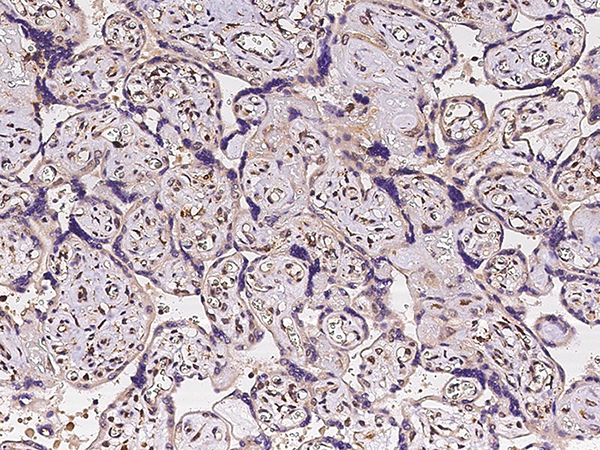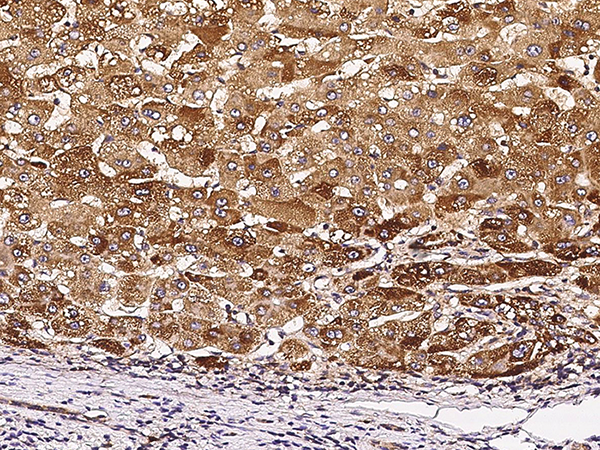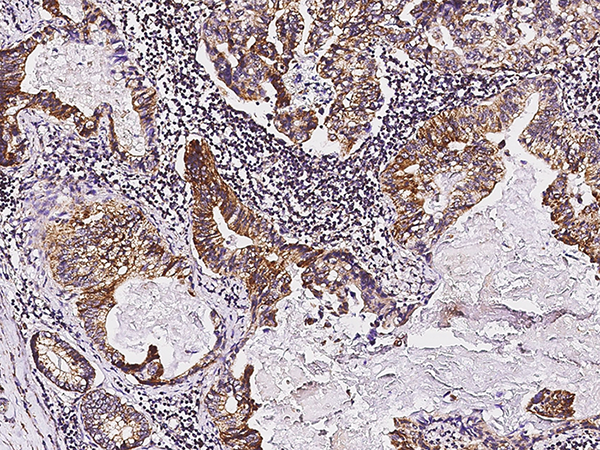-
Product Name
Anti-Tie1 antibody
- Documents
-
Description
Mouse monoclonal to Tie1
-
Tested applications
IHC-P
-
Species reactivity
Human Tie1
No cross-reactivity in ELISA with \ -
Alternative names
TIE antibody; D430008P04Rik antibody; JTK14 antibody; RP11-282K6.6 antibody; RP23-145E1.8 antibody; TIE antibody; TIE1 antibody; Tie1 antibody; tie-1 antibody; TIE antibody; tie-1 antibody; D430008P04Rik antibody; TIE antibody; JTK14 antibody
- Immunogen
-
Isotype
Mouse IgG2b
-
Preparation
This antibody was produced from a hybridoma resulting from the fusion of a mouse myeloma with B cells obtained from a mouse immunized with purified, recombinant Human Tie1 (rh Tie1; NP_005415.1; Met 1-Gln 760). The IgG fraction of the cell culture supernatant was purified by Protein A affinity chromatography.
-
Clonality
Monoclonal
-
Formulation
0.2 μm filtered solution in PBS with 5% trehalose
-
Storage instructions
This antibody can be stored at 2℃-8℃ for one month without detectable loss of activity. Antibody products are stable for twelve months from date of receipt when stored at -20℃ to -80℃. Preservative-Free.
Sodium azide is recommended to avoid contamination (final concentration 0.05%-0.1%). It is toxic to cells and should be disposed of properly. Avoid repeated freeze-thaw cycles. -
Applications
IHC-P: 5-20 μg/mL
-
Validations

Tie1 Antibody, Mouse MAb, Immunochemistry
Immunochemical staining of human TIE1 in human placenta with mouse monoclonal antibody (15 µg/mL, formalin-fixed paraffin embedded sections).

Tie1 Antibody, Mouse MAb, Immunochemistry
Immunochemical staining of human TIE1 in human liver(cirrhosis) with mouse monoclonal antibody (15 µg/mL, formalin-fixed paraffin embedded sections).

Tie1 Antibody, Mouse MAb, Immunochemistry
Immunochemical staining of human TIE1 in human stomach carcinoma with mouse monoclonal antibody (15 µg/mL, formalin-fixed paraffin embedded sections).
-
Background
Tyrosine kinase with immunoglobulin-like and EGF-like domains 1 also known as Tie1 is an angiopoietin receptor and is an orphan receptor tyrosine kinase that is expressed almost exclusively in endothelial cells and that is required for normal embryonic vascular development. The receptor tyrosine kinase Tie1 is expressed primarily in vascular endothelial cells. The receptor has also been detected in epithelial tumours in breast, thyroid and gastric cancers and in tumour cell lines where it appears as a 45 kDa truncated receptor fragment. Tie1 promotes endothelial cell survival, but other studies have suggested that the Tie1 kinase has little to no activity. Embryos deficient in Tie1 failed to establish structural integrity of vascular endothelial cells, resulting in oedema and subsequently localized haemorrhage. Tie1 is significantly higher in human aortic endothelial cells than in human umbilical vein endothelial cells. Additionally, attachment of cells of monocytic lineage to endothelial cells is also enhanced by Tie1 expression. Collectively Tie1 has a proinflammatory property and may play a role in the endothelial inflammatory diseases such as atherosclerosis.
-
References
- Chan B, et al. (2008) Receptor tyrosine kinase Tie-1 overexpression in endothelial cells upregulates adhesion molecules. Biochem Biophys Res Commun. 371(3): 475-9.
- Sato TN, et al. (1995) Distinct roles of the receptor tyrosine kinases Tie-1 and Tie-2 in blood vessel formation. Nature. 376(6535): 70-4.
- Rees KA, et al. (2007) The receptor tyrosine kinase Tie1 is expressed and activated in epithelial tumour cell lines. Int J Oncol. 31(4): 893-7.
- Kontos CD, et al. (2002) The endothelial receptor tyrosine kinase Tie1 activates phosphatidylinositol 3-kinase and Akt to inhibit apoptosis. Mol Cell Biol. 22(6): 1704-13.
Related Products / Services
Please note: All products are "FOR RESEARCH USE ONLY AND ARE NOT INTENDED FOR DIAGNOSTIC OR THERAPEUTIC USE"
